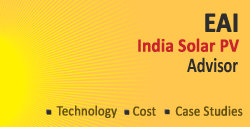India Solar Energy
Introduction[i] India is in the sunny regions of the world with most parts of the country receiving 4-7wh (kilowatt-hour) of solar radiation per square meter per day 250-300 sunny days in a year. Rajasthan receives the highest annual solar radiation and North-eastern parts of the country receive the least. This solar energy can be made use of in two ways the Thermal route i.e. using heat for drying, heating cooking or generation of electricity or through thePhotovoltaic route which converts light in solar energy in to electricity which can be used for a myriad purposes such as lighting, communication, pumping and generation of electricity. With its pollution free nature, virtually inexhaustible supply and global distribution makes solar energy very attractive. Technology Solar Photovoltaic’s [ii] Solar photovoltaic’s (SPV) are in the process of converting solar radiation (sunlight) into electricity using a device called solar cell. A solar cell is a semi-conducting device made of silicon or other materials, which, when exposed to sunlight, generates electricity. The magnitude of the electric current generated depends on the intensity of the solar radiation, exposed area of the solar cell, the type of material used in fabricating the solar cell, and ambient temperature. Solar cells are connected in series and parallel combinations to form modules that provide the required power. SPV Technology Solar Thermal[iii] Solar Thermal Power systems, also known as Concentrating Solar Power systems, use concentrated solar radiation as a high temperature energy source to produce electricity using thermal route. In the basic process of conversion of solar into heat energy, an incident solar irradiance is collected and concentrated by concentrating solar collectors or mirrors, and generated heat is used to heat the thermic fluids such as heat transfer oils, air or water/steam, depending on the plant design, acts as heat carrier and/or as storage media. The hot thermic fluid is used to generated steam or hot gases, which are then used to operate a heat engine. In these systems, the efficiency of the collector reduces marginally as its operating temperature increases, whereas the efficiency of the heat engine increases with the increase in its operating temperature. Concentrating solar collectors Solar collectors are used to produce heat from solar radiation. High temperature solar energy collectors are basically of three types: Capacity Installed[iv] India is in the sunny regions of the world with most parts of the country receiving 4-7wh (kilowatt-hour) of solar radiation per square meter per day 250-300 sunny days in a year. Click here for potential locations Current Projects Photovoltaic Projects[vi] Solar Thermal Projects

| Projects |
|---|
| 1. Solar Thermal Power Plant of 50kW capacity has been installed by MNES following the parabolic trough collector technology (line focussing) at Gwalpahari, Gurgaon, which was commissioned in 1989 and operated till 1990, after which the plant was shut down due to lack of spares. |
| 2. A Solar Thermal Power Plant of 140MW at Mathania in Rajasthan, has been proposed and sanctioned by the Government in Rajasthan. The project configuration of 140MW Integrated Solar Combined Cycle Power Plant involves a 35MW solar power generating system and a 105MW conventional power component and the GEF has approved a grant of US$ 40 million for the project. The Government of Germany has agreed to provide a soft loan of DM 116.8 million and a commercial loan of DM 133.2 million for the project. |
| 3. A commercial power plant based on Solar Chimney technology was also studied in North-Western part of Rajasthan. The project was to be implemented in five stages.In the 1st stage the power output shall be 1.75MW, which shall be enhanced to 35MW, 70MW, 126.3MW and 200MW in subsequent stages. The height of the solar chimney, which would initially be 300m, shall be increased gradually to 1000m. Cost of electricity through this plant is expected to be Rs. 2.25 / kWh. However, due to security and other reasons the project was dropped. |
| 4. BHEL limited, an Indian company in power equipments manufacturing, had built a solar dish based power plant in 1990’s as a part of research and development program of then the Ministry of Non-conventional Energy Sources. The project was partly funded by the US Government. Six dishes were used in this plant. |
| 5.140 MW ISCC plant with 35 MW solar capacity |
Barriers Solar Research Centers The Energy and Resources Institute (TERI) TERI was formally established in 1974 with the purpose of tackling and dealing with the immense and acute problems that mankind is likely to be faced with in the years ahead. on account of the gradual depletion of the earth’s finite energy resources which are largely non-renewable. The Solar Energy Centre (SEC), established in 1982, is a dedicated unit of the Ministry of New and Renewable Energy, Government of India for development of solar energy technologies and to promote its applications through product development. Centre for Renewable Energy and Environment Development (CREED) The objectives of the centre are to The Solar Energy of India (SESI) The Solar Energy of India (SESI), established in 1976, and having its Secretariat in New Delhi, is the Indian section of the International Solar Energy Society (ISES). Its interests cover all aspects of renewable energy, including characteristics, effects and methods of use, and it provides a common ground to all those concerned with the nature and utilization of this renewable non-polluting resource. Auroville Centre for Scientific Research (CSR) Auroville Centre for Scientific Research (CSR) is an international voluntary organization working towards a sustainable future in the field of renewable energy systems (wind, solar, biomass), appropriate architecture & building technologies, waste water recycling and sanitation, and the transfer of these technologies through training programs. CSR receives grants and donations for its programmes and research projects from Indian and foreign governmental and non-governmental agencies, and from well-wishers worldwide. Apex bodies [i] http://mnes.nic.in/booklets/Book4-e.pdf
(i) Conceive, develop, and implement renewable energy application and environment protection projects
(ii) Develop courses and organize awareness creation programs
(iii) Collaborate with national and international organizations and institutions in the areas of renewable energy education, training and technology development.
The centre is presently collaborating with MNES, IREDA, REDA, ARTES Institute, of Flensburg University, Germany, and CEER of SPIC Science Foundation, Chennai.
The centre is actively involved in setting up performance evaluation of
Solar Energy Society of India
A-14, Mohan Cooperative
Industrial Estate
Mathura Road
New Delhi – 110044
Tel. : +91.11.65649864, 26959759
Tele fax : +91.11.26959759
India Semiconductor Association
UNI Building, 4th Floor,
Millers Tank Bund Road,
Bangalore - 560 052
Telephone: +91-80-4147 3250
Facsimile: +91-80-4122 1866
[ii] http://mnes.nic.in/booklets/Book4-e.pdf
[iii] aprekh.org/files/SolarThermalPowergeneration_Final.pdf
[iv] http://mnes.nic.in/booklets/Book4-e.pdf
[v] http://mnes.nic.in/booklets/Book4-e.pdf
[vi] http://mnes.nic.in/annualreport/2002_2003_English/ch5_pg10.htm






 Free EAI Newsletter
Free EAI Newsletter
